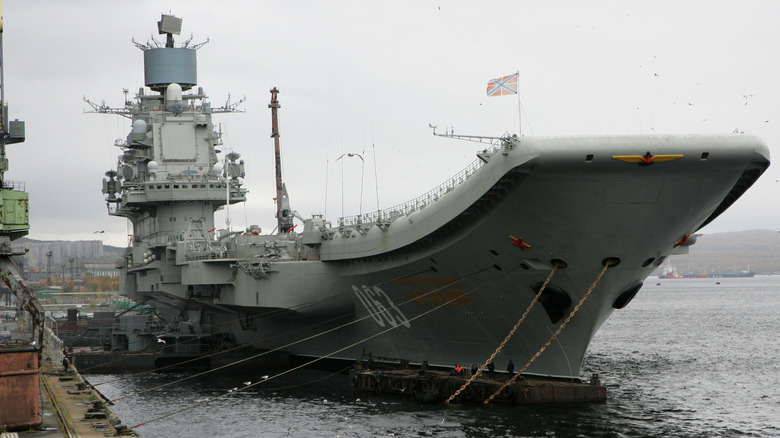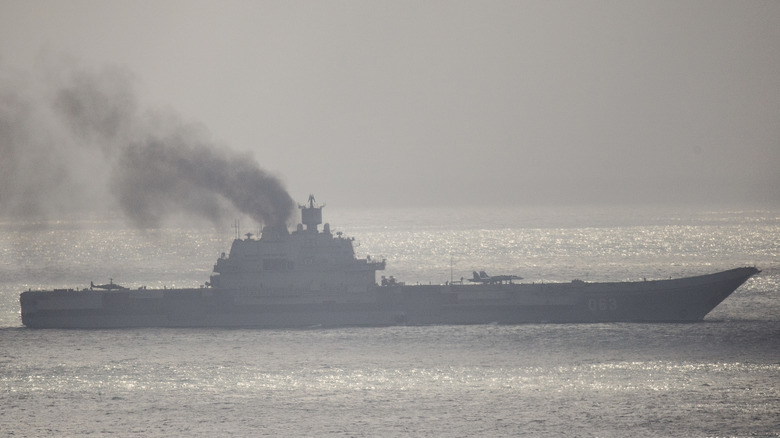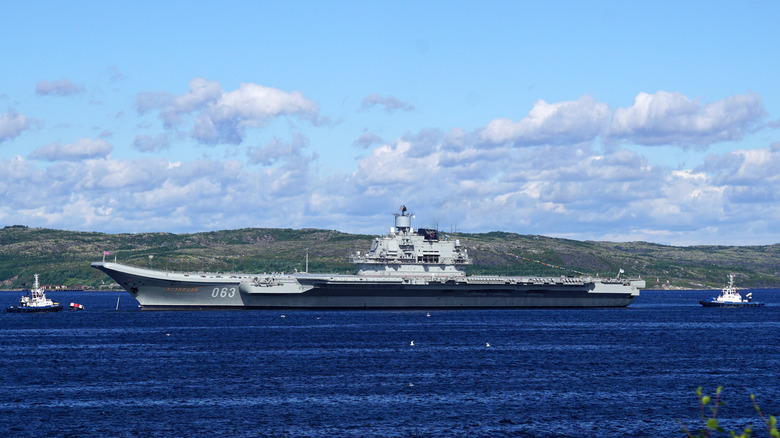What Made The Admiral Kuznetsov One Of The Worst Aircraft Carriers Ever Built?
War with Russia is frightening to imagine, but it's not because of the Russian navy. Unlike the U.S. Navy and its 11 nuclear-powered aircraft carriers, Russia only has one carrier and it's not even nuclear-powered. That's not necessarily what makes it one of the worst aircraft carriers of all time, although the dark-smoke-producing mazut it uses as fuel isn't exactly the most efficient for a modern-day carrier. The Admiral Kuznetsov isn't a modern carrier and has never been brought up to date to compete with them. The Soviet Union built the Kuznetsov but when the USSR collapsed, Russia didn't have — and has never had — the ability to make regular updates.
Ignoring the fact that the carrier has been plagued by disaster after disaster since it was brought in for repairs in 2017, it doesn't quite have the show of force a carrier should have. Unlike America's newest class of carrier, the Gerald R. Ford class, which supports up to 90 aircraft, the Admiral Kuznetsov only houses up to 24 fighter jets and 12 helicopters. The one advantage the Kuznetsov has over most other carriers around the world is that it's the only carrier armed with 12 P-700 Granit anti-ship cruise missiles as well as nearly 200 air-to-surface missiles.
It might not have much to show off in the way of air power, but it can likely defend itself well enough if threatened by adversaries. That, is if it ever gets back to sea.
There's never any telling when it will malfunction
During a three-month tour to Syria in 2012, Russia's only aircraft carrier experienced one of its lowest points. While it was passing through Bay of Biscay near France — 2,700 miles from Russia — the Russian aircraft carrier lost propulsion power, forcing it to drift. Understandably embarrassed by the situation, Russia chose to hide it.
The crew was never able to restore propulsion to get home; instead, it had to rely on the impressive power of the tugboat Nikolay Chiker. The tugboat wasn't called from Russia, however. It was cruising right alongside the Kuznetsov because its sole purpose was to help the failing carrier whenever it broke down. In fact, a cargo ship once escorted the Admiral Kuznetsov, loaded with spare parts to assist with repairs.
This was hardly the carrier's only problem. Three years earlier, a crew member died in a fire caused by a problem with the electrical system. And its arresting cables are prone to failing, which have caused a few aircraft collisions. A failure with the arresting cables in 2016 forced a MiG-29K fighter into a holding pattern, but before the ship's crew could repair the cables, the aircraft lost power in both of its engines. Weeks later the carrier lost an SU-33. The ship's air wing ended up transferring to a land air base to continue its work.
The Admiral Kuznetsov is a relic plagued by disasters
Unlike America's Nimitz- and Gerald R. Ford-class aircraft carriers that either use a steam-powered or electromagnetic catapult system to launch fixed-wing aircraft, the Admiral Kuznetsov relies on a ski ramp. Aircraft using a ski ramp to take off from a carrier have to be lighter than those launched by catapults, limiting the type that can be stationed aboard the Kuznetsov, and their payload.
The Admiral Kuznetsov had been in need of upgrades for many years when Russia brought it in to be overhauled. In 2018, shortly after the flattop was placed in Russia's largest dry dock, the dry dock sank. A year later, when repairs resumed, a fire broke out aboard. At least one person was killed. One would think the Russian government would finally put the Kuznetsov out of its misery and scrap it, but it seems determined to make the Cold War-era vessel work.
Some in the Russian government have considered retrieving the Kuznetsov's sister ship that it sold to China, which has since become China's first aircraft carrier, the Liaoning. However, Russia doesn't feel the need to beef up its carrier presence around the world because it doesn't value carriers the same way America and other Western nations do. It's primarily a land power, as it doesn't have the ports to support carriers. Not to mention the nation hasn't had the best of luck with a navy, overall.


